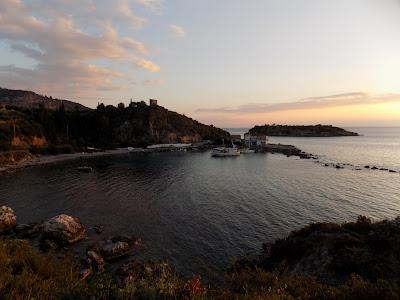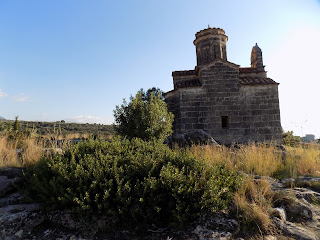 |
| The harbor at sunset in Kardamyli, Greece |
This winter I spent about a month traveling through mainland Greece, as I've talked about in the last few posts about Kalamata, Thessaloniki and Meteora. I spent a good part of that time staying in the southern city of Kalamata in the Peloponnese region, thanks to its sunny weather and great beaches. Even in the winter it was a great place to relax in the sunshine.
One of the best things about Kalamata is that it's a great place to stay if you want to go out on day trips and explore the little seaside towns of the Peloponnese. In the peak season, this whole region gets crowded and expensive, but if you go in the winter like we did, you can still have warm weather and enjoy all the sights without the crowds.
The first day trip we went on from Kalamata was to the little coastal town of Kardamyli. We took a local bus from the terminal in Kalamata, which I think cost around 4 euros, and took about an hour. The ride out there went through some of the most beautiful countryside that I saw in Greece.
 |
| A cobblestone street in Kardamyli |
Kardamyli is a small town with a little harbor area and a few nice restaurants and bars. It's unbelievably picturesque, with a lot of little charming houses and some old churches. The town is so old that it existed in Homer's time, and even got a mention in the Iliad (it was one of the seven cities offered to Achilles to entice him to fight in the Trojan War.)
In the older part of town you can see the Church of St. Spyridon and next to it an old fortress and tower. For a small fee you can go and look around inside the fortress and climb up the tower, which has a nice view of the town and ocean.
 |
| St Spyridon church |
 |
| Old fortress in Kardamyli |
One downside to going in the winter was that we couldn't access some of the great hiking that exists near Kardamyli, such as the trails up Mt. Taygetus or the Viros Gorge. But we did do a short hike up a hill overlooking the town, where we found one of the most interesting Byzantine churches. It was tiny, and a local woman who went in to do some cleaning was nice enough to let us come in and look around. The icons inside looked really old and many seemed to have survived some kind of damage, perhaps from a fire.
 |
| An old church in Kardamyli |
The trail up the hill to this church started from the Church of St. Spyridon. It wasn't a very difficult hike and took about thirty minutes for us to get to the top. Along the way was another really interesting historic site: the tombs of the Dioskouri, Castor and Pollux (or Kastor and Polydeuces in Greek).
 |
| Hiking in Kardamyli |
 |
| The tombs of the Dioskouri in Kardamyli |
Castor and Pollux were twin brothers whose mother was Leta, but they somehow (pagan magic?) had different fathers. Castor was the son of the king of Sparta and thus mortal, while Pollux was the half-god son of Zeus who, being the creep that he is, had seduced Leta in the form of a swan. If you go to an archaeological museum in Greece, there's a good chance you're going to see a risque swan/woman statue at some point, so be warned. One of my favorite online comics, Hark a Vagrant, did a hilarious comic strip on the weird Zeus/Leta myth, which you can read here.
Apparently Castor and Pollux had twin sisters, who were Clytemnestra and the famous Helen of Troy. According to some stories, they were born from an egg - I guess that's the swan influence.
When Castor was killed Pollux asked Zeus to let him save Castor using his own immortality, which Zeus interpreted to mean that they wanted to become a constellation. And thus we have the constellation Gemini (the twins).
The sign on the tomb says that while tradition attributes the site to the Dioskouri, some people also say it might have been for the heroes Nikomachos and Gorgasos, who were famous for their healing powers. Either way, it claims the site is from the 3rd-2nd century B.C.
The other day trip we did from Kalamata was in the opposite direction, toward the west, to the coastal town of Pylos. Pylos is much bigger than Kardamyli, with a beautiful harbor area and the rest of the town perched on the hills surrounding it. It's in the Bay of Navarino, which is an incredibly beautiful area. The bay forms nearly a circle, with a thin strip of little hilly land with gorgeous beaches wrapping around the far side from Pylos.
 |
| Pylos, Greece in the Bay of Navarino |
Pylos has an unbelievably long history and can actually trace the presence of humans in the area all the way back to the Neolithic period. It also got a mention in Homer's writings as the Palace of Nestor, a king from the Homeric times. It was an important area in Mycenae, the ancient name for the region of Greece that includes Kalamata and Kardamyli.
 |
| King Nestor and his sons making a sacrifice to Poseidon in Pylos (Photo credit) |
On one of the hills overlooking the harbor is a fort that features in a lot of the tourism photos of the area, probably because of its unusual hexagonal shape. It is actually the "new" fortress of Pylos, built by the Turks in the 16th century. It's in good condition and you can walk up on the walls which over a great view of the Bay of Navarino. There are a couple of small but interesting museums on the grounds as well that show how archaeologists are working to recover and restore artifacts found in the ocean.
 |
| The "new" fortress in Pylos, built in the 16th century |
 |
| View of the Bay of Navarino from the new fortress in Pylos |
 |
| Human remains recovered from the ocean in the Peloponnese region, in the museum at the fortress |
There is an old Pylos castle as well, which we didn't visit during our trip, which was built in the 13th century and might be worth a visit as well.
Without access to a car, we were limited to what we could see just in town, but it was still a lovely place to spend the day. I really enjoyed walking around the fortress and then just wandering through the town. The views and the fresh ocean air were fantastic and the narrow roads that wound up and down the hills through town had a lot of character. It's hard to believe as you walk through them that a city of some form had existed on that same spot for thousands of years.
 |
| The countryside around Kardamyli |
More posts about Greece:















Comments
Post a Comment